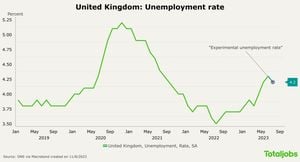The world is witnessing one of the most transformative demographic shifts of our time: the rapid aging of populations. This trend poses significant challenges and opportunities, particularly for public policy and development. With countries grappling with an increasing proportion of elderly citizens, the need for effective resource allocation within health care, social services, and urban planning has never been more pressing.
According to the United Nations' World Population Prospects 2024, the proportion of people aged 65 and older is expected to surge from 10% to 16% by 2050. This shift is not just about numbers; it also highlights the pressing need to adapt public policies to accommodate the needs of aging populations. For many regions, this adaptation will require innovation and collaboration among governments, societies, and markets.
Take, for example, China, the world's most populous developing nation. The country is experiencing one of the fastest aging processes due to increased life expectancy combined with declining birth rates. Currently, China's aging population brings with it unmistakable demographic challenges, including disparities between urban and rural eldercare resources. Research highlights these inequalities, noting significant differences not only across geographic areas but also among socioeconomic groups.
A recent study published in Humanities and Social Sciences Communications reveals the dynamic and often inequitable allocation of elderly care resources across urban and rural areas from 2008 to 2021. The data shows urban institutions receiving more resources than their rural counterparts, underscoring the urgent need for balanced public investment. Without effective intervention, these disparities could exacerbate the already unequal access to healthcare and elder services for rural populations.
But what does this all mean for our public policies? Generally, as the demand for pensions, healthcare, and long-term services continues to soar, the societal strain on these systems is palpable. Many elderly people are finding it increasingly challenging to obtain the care and services they need, raising questions about the adequacy of traditional family-oriented models of eldercare. With fewer children per family, often living far away from their aging parents, society is gradually shifting its reliance onto community and institutional care options.
The aging trend is not exclusive to China. Across the globe, other nations face similar issues. Researchers estimate about 270 million people over the age of 65 are residents of developed countries such as the U.S. and those across Europe. Interestingly, baby boomers, the group born between 1946 and 1964, now constitute 20% of the U.S. population yet own over 50% of the nation’s wealth. This also raises important economic questions: How will wealth be transferred to the younger generations, and how will this impact consumption patterns?
Alongside economic concerns, there’s also growing apprehension surrounding quality of life. Dr. Mingyang Li and his colleagues noted the lack of standardized care protocols and assessment systems for eldercare services, which skew the available data and hinder effective policymaking. Urban areas enjoy superior care facilities and higher-quality services compared to those found in rural settings, where services are often homogenous and subpar. Further complicate matters are the compounded effects of economic disparities, limited infrastructure, and shortages of professional caregivers.
For other nations, learning from China's challenges could offer invaluable insights. The aging population might compel governments to reevaluate their resource allocation methods, ensuring they are equitable and effective. Rethinking urban and rural resource disparities should also prompt countries to advocate for greater investment from both public and private sectors to improve eldercare services, particularly in underserved areas.
Policy recommendations are beginning to emerge, highlighting the need for collaborative strategies. For example, fostering partnerships between the government and private sectors can lead to the creation of more efficient service models dissecting economic and social barriers to caregiving. Proactive efforts may reflect initiatives like developing training programs for eldercare workers, enhancing public subsidies for elderly services, particularly where care is lacking, and revising regulations to support elderly-friendly community planning.
Collaboration and innovative public policies also promise to make substantial impacts on the so-called "silver economy" – the economic output generated by the activities of the elderly and their caregivers. Governments have established advisory panels to address how to best meet the needs of aging populations, highlighting the silver economy's potential for global economic growth.
Studies suggest baby boomers are more financially prudent than youthful generations and display cautious spending habits. While this might not substantially contribute to immediate consumption increases, it does warrant attention from businesses and policymakers concerning how this generation will engage with the economy over time. The financial behaviors of the upcoming generations inheriting significant wealth will also play a pivotal role.
Another unique opportunity arises through the lens of consumer behavior as younger generations (Generation Y and Z) start to inherit considerable wealth from their parents and grandparents. These tech-savvy, educated groups possess different values compared to the baby boomers, focusing more on sustainability and social responsibility, including issues such as climate change and product safety. Indeed, their spending habits will likely shift global markets, presenting fresh opportunities particularly within industries like culture, tourism, telecommunications, and asset management.
While the current panoply of demographic challenges grows, the frameworks for alleviating pressure on public services continue to expand. Policymakers might need to anticipate how these trends impact labor markets, economic growth potential, and family structures. The future of elder care and societal resource allocation hinges on addressing the peculiarities bestowed by our aging populace.
The heart of these challenges lies not solely within health care but also within the broader scope of public policy. By ensuring equitable resource distribution, crafting thoughtful eldercare policies, and encouraging economic adaptability among the younger workforce, societies can potentially flourish amid the intensifying demographic changes of this century.
Overall, the impact of aging populations on public policy and development continues to develop, presenting myriad issues—all key to maintaining social and economic welfare. The future may be complex, but with thoughtful policy engagement and community participation, it can be navigated effectively.



